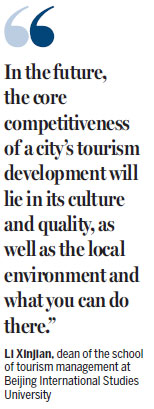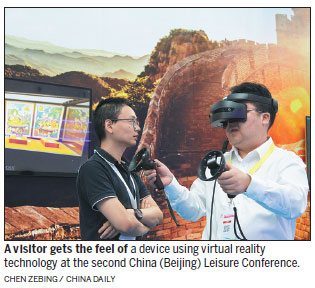Culture, heritage help megacity climb rankings
Beijing ranks among the top three leisure cities in China, says a report the city has issued.
The 2018 ranking of leisure cities in China was unveiled at a city and leisure tourism forum during the China (Beijing) Leisure Conference on Sept 21.
This year the ranking took into consideration the relationships between cities and tourism, culture, heritage and environmental protection.
Objective data, market index analysis and experts reviews were all taken into account, organizers said.
The other two cities in the top three were Shanghai and Sanya in Hainan province.

Leisure makes a city more beautiful, said Li Xinjian, dean of the school of tourism management at Beijing International Studies University. The implication of that is that city dwellers should have a humanistic spirit and more comfortable life, Li said.
A city also needs a systemic approach to its planning that takes into consideration urban planning, public services and its development as a tourist destination, Li said.
"In the future, the core competitiveness of a city's tourism development will lie in its culture and quality, as well as the local environment and what you can do there."
One company that is drawing on its cultural heritage to attract visitors is Beijing Longxinghao Fangzhuang Distillery, a time-honored liquor brand in Beijing.
The company is known for its traditional liquor-making methods, which have been added to Daxing district's list of intangible culture heritage.
The company produces more than 160 kinds of grain-made liquor and has a 20-hectare liquor culture industrial park, covering production, a museum, a sorghum plantation and a storage area.
Longxinghao has preserved its ancient methods featuring pure handmade brewing techniques, said Su Xing, a salesman with the company.
"Supported by the Daxing district government, the distillery uses Daxing district's traditional liquor brewing technologies, which originated in 1688," Su said.
In 2016 the company opened a 4,000-square-meter liquor museum in the district.
It has about 10,000 items on display, including distillery tools such as a steamer, baskets and ancient cellar pools.
The museum has also set up sections to illustrate liquor making and display its customized product lineup, giving visitors the chance to experience liquor making and drinking.
The aim is to integrate Beijing's liquor culture into people's life, the company said.
"Leisure and industrial resources are the core matters of our generation," said Li Ji, director of the cultural planning and design center of Tsinghua University.
"They can be regarded as a legacy that we can pass to the coming generations by sharing what cultural leisure has to offer."
liangkaiyan@chinadaily.com.cn

(China Daily 09/28/2018 page10)














